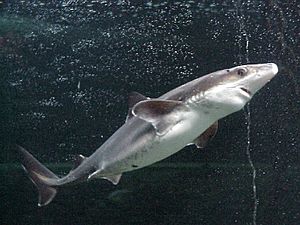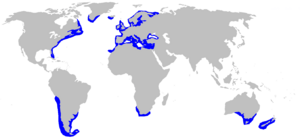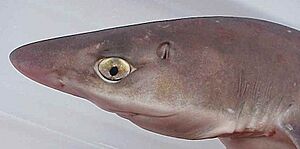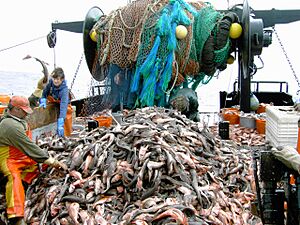Spiny dogfish facts for kids
Quick facts for kids Spiny dogfish |
|
|---|---|
 |
|
| Conservation status | |
| Scientific classification | |
| Kingdom: | |
| Class: | |
| Order: |
Squaliformes
|
| Family: | |
| Genus: |
Squalus
|
| Binomial name | |
| Squalus acanthias |
|
 |
|
| Range of the spiny dogfish | |
The spiny dogfish (Squalus acanthias) is a very common type of shark. It is a small shark, usually about 28 to 39 inches (70 to 100 cm) long. The biggest ones can weigh up to 9.8 kg.
You can find spiny dogfish in the Atlantic Ocean and the Pacific Ocean. They live from the ocean's surface down to very deep waters, sometimes as deep as 1,460 meters. These sharks mostly eat fish that swim in the open ocean, like herring and mackerel.
Contents
What Does a Spiny Dogfish Look Like?
The spiny dogfish has a long, thin body and a flat head. Its snout is narrow and pointed. This shark also has quite large eyes.
It has two main fins on its back, called dorsal fins. The first dorsal fin is about halfway between its front fins (pectoral fins) and its back fins (pelvic fins). The second dorsal fin is smaller, about two-thirds the size of the first. It is located behind the pelvic fins.
Each dorsal fin has a sharp spine in front of it. This is how the spiny dogfish gets its name! The first spine is about half as long as the second one. The front fins look like triangles with rounded tips. The back fins are closer to the second dorsal fin than the first. This shark does not have an anal fin. Its tail fin does not have a notch on the top part, and the bottom part is not very developed.
The top of the dogfish is a grey-blue color, sometimes with a brownish tint. It has rows of white spots along each side. These spots are usually brighter on younger sharks and fade as they get older. Sometimes, the spots disappear completely. The edges of its dorsal fins and tail fin are dark when they are born, but this color quickly fades. The underside of the dogfish is light grey or white.
Most spiny dogfish are between 28 and 39 inches (70 to 100 cm) long. Adult males are usually 24 to 35 inches (60 to 90 cm). Adult females are a bit longer, from 30 to 42 inches (76 to 107 cm). The longest male found was 39 inches (100 cm), and the longest female was 49 inches (124 cm). Adult females can weigh 3.2 to 4.5 kg (7 to 10 pounds). The heaviest one ever recorded weighed 9.8 kg (22 pounds).
Where Do Spiny Dogfish Live?
Spiny dogfish live in many parts of the world. In the western Atlantic Ocean, they are found from Greenland down to Argentina. In the eastern Atlantic, they live from Iceland and Russia down to South Africa. They are also found in the Mediterranean Sea and the Black Sea.
In the western Pacific Ocean, these sharks live from the Bering Sea to New Zealand. In the eastern Pacific, they are found from the Bering Sea down to Chile.
These sharks usually live near the ocean floor, but they can also swim in open water. They are found from the surface down to depths of 1,460 meters. Spiny dogfish prefer seawater, but they can sometimes be found in slightly salty water. They like water temperatures between 7 and 15 °C. You can find them close to shore or far out in the ocean. They often swim into bays and estuaries. They have been seen in freshwater, but they cannot live there for long.
Who Eats Spiny Dogfish?
Other animals eat spiny dogfish. They have been found in the stomachs of fish like cod and red hake. Other types of dogfish also eat them. Bigger sharks, seals, and Killer whales also hunt spiny dogfish.
To protect themselves, spiny dogfish can curl their bodies into a bow shape. Then, they strike at predators with the sharp spines on their dorsal fins.
What Do Spiny Dogfish Eat?
Spiny dogfish usually hunt for food in groups. They mostly eat fish that live in the open ocean, such as herring, menhaden, capelin, sand lance, and mackerel. They often eat a lot of these fish.
Sometimes, spiny dogfish bite through fishing nets to get to the fish caught inside. This has given them a bad name among fishermen. They also eat other things like molluscs (like squid and octopus), crustacea (like shrimp and crab), jellyfish, sea cucumbers, algae, smaller sharks, and even shark egg cases.
Spiny Dogfish Life Cycle
The spiny dogfish has a very long gestation period, which means how long the babies grow inside the mother. It can last up to 2 years!
Spiny dogfish are ovoviviparous. This means the babies develop inside eggs while still inside the mother. The eggs have yolk sacs that feed the growing embryos. When the babies are ready, the mother gives birth to 1 to 20 live pups. Each new pup is about 20 to 33 centimeters long. Spiny dogfish can live for a very long time, from 20 to 75 years.
Spiny Dogfish and Humans
Spiny dogfish are not usually dangerous to humans. However, if you don't handle them carefully, their sharp dorsal fin spines can cause a painful wound. Fishermen sometimes don't like spiny dogfish because they bite through nets to steal fish.
Even though the spiny dogfish is the most common shark, some groups in the Atlantic Ocean are in danger. This is because too many of them have been caught by fishing, which is called overfishing. People catch these sharks for food, for oil from their livers, and to make things like sandpaper, vitamins, leather, and pet food. In the early 1900s, it was thought that up to 27 million spiny dogfish were caught off the coast of Massachusetts every year.
Protecting Spiny Dogfish
Because spiny dogfish have a long gestation period and only a few pups at a time, they need to be managed carefully. They are very easily affected by overfishing and are currently at risk.
Fishermen often try to catch mature female sharks because they are larger. In the U.S.A., fishing for spiny dogfish increased a lot in the 1990s. This caused the number of adult females to drop by 75%, which meant fewer new pups were born.
To help the sharks, rules have been put in place. In 2001, an emergency rule closed some waters to dogfish fishing. In 2002, a plan was approved to manage spiny dogfish fishing. In 2003, federal waters were closed to dogfish fishing because new information showed their populations were still decreasing. The IUCN now lists the spiny dogfish as a Vulnerable species. This means they are at risk of becoming endangered.
Images for kids
See also
 In Spanish: Mielga para niños
In Spanish: Mielga para niños









